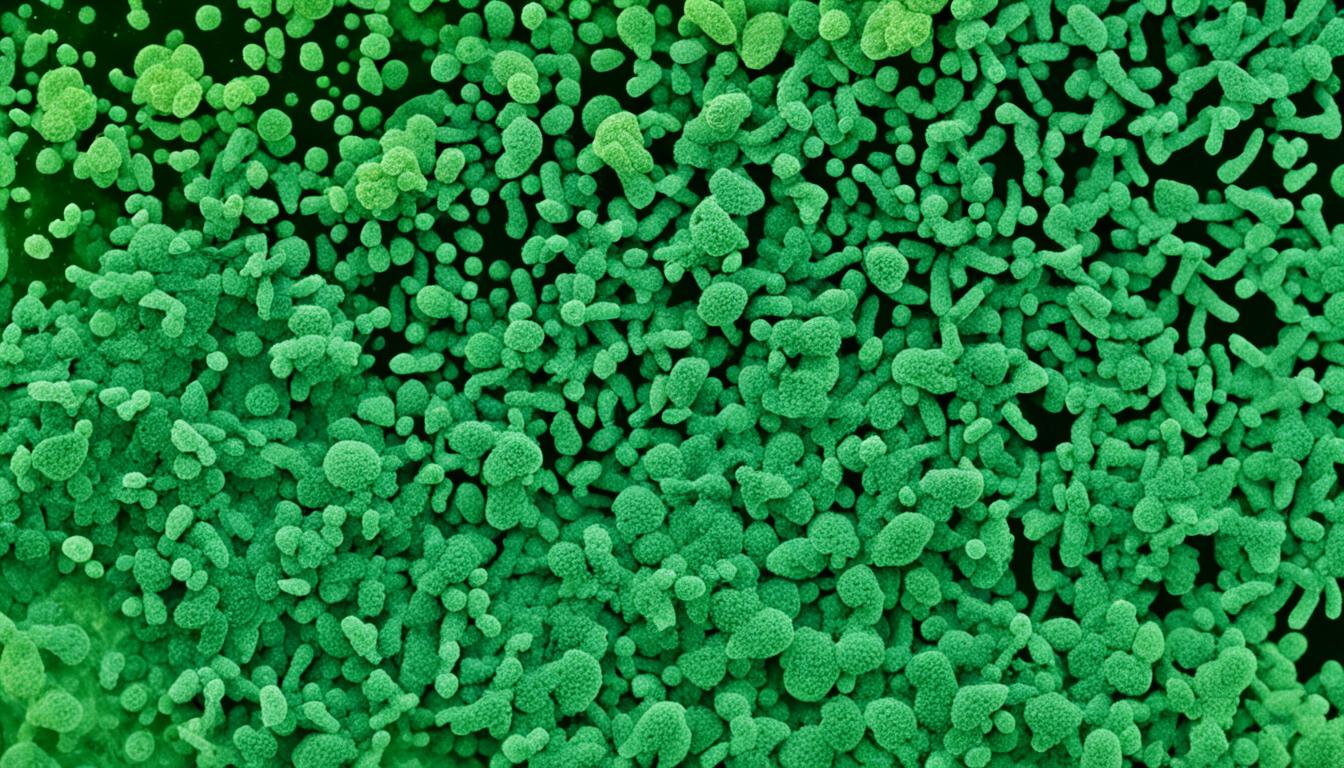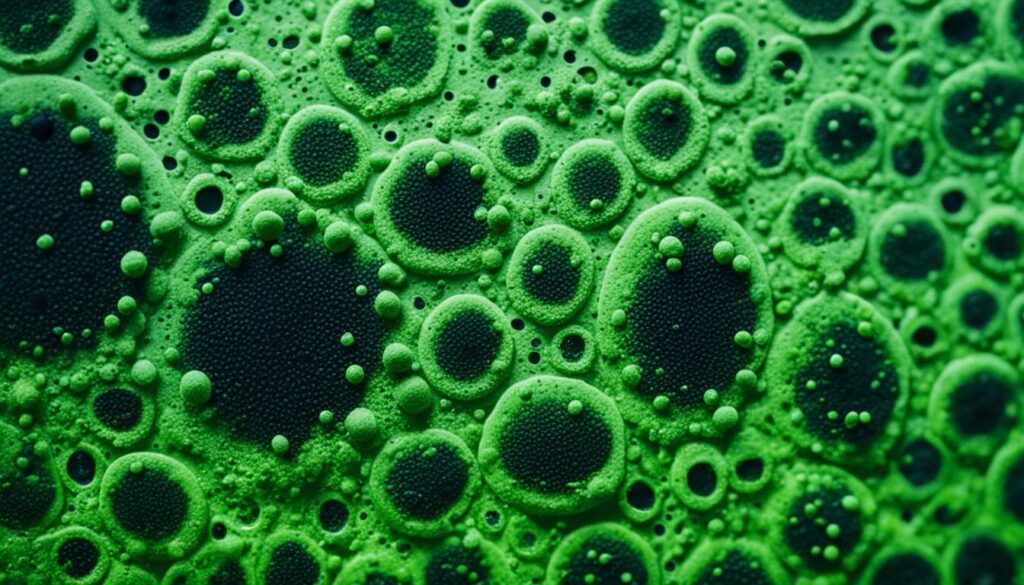
Health Risks of Cladosporium Mold – Fact Check
When it comes to the presence of mold in our indoor and outdoor environments, understanding the potential health risks is of utmost importance. Cladosporium mold, in particular, has garnered attention for its prevalence and potential impact on human health. In this section, we will delve into the truth behind the question: Is Cladosporium mold dangerous?
Before we can accurately assess the health risks associated with Cladosporium mold, it is essential to gain a comprehensive understanding of this particular type of mold. By examining its characteristics and common sources, we can better grasp its potential effects on our well-being. Let’s explore Cladosporium mold together.
Key Takeaways:
- Cladosporium mold is a type of mold that can be found in both indoor and outdoor environments.
- Understanding the potential health risks associated with Cladosporium mold is crucial for maintaining a safe living environment.
- By gaining knowledge about Cladosporium mold, we can take proactive measures to minimize exposure and promote overall well-being.
- Seeking professional assistance, such as Fix Mold Miami, can help ensure accurate assessments and effective remediation of Cladosporium mold issues.
- Stay tuned as we dive deeper into the effects of Cladosporium mold exposure and explore the best practices for prevention and remediation.
Understanding Cladosporium Mold
Cladosporium mold, also known as Cladosporium spp., is a common type of mold found both indoors and outdoors. It belongs to the Ascomycota division of fungi and is typically characterized by its olive-green or black color.
Indoor sources of Cladosporium mold include damp areas such as bathrooms, kitchens, basements, and crawl spaces. It can also thrive on organic materials like wood, carpet, wallpaper, and moist surfaces.
Outdoor sources of Cladosporium mold include plants, soil, decaying vegetation, and outdoor structures. It is commonly found in areas with high humidity, such as forests, gardens, and compost piles.
Exposure to Cladosporium mold can have various health effects. The mold releases spores into the air, which can be inhaled or come into contact with the skin. Individuals with weakened immune systems, allergies, or pre-existing respiratory conditions may be more susceptible to the health effects of Cladosporium mold.
For a better understanding of Cladosporium mold and its effects on human health, refer to the following table:
| Health Effects of Cladosporium Mold | Common Symptoms |
|---|---|
| Respiratory Irritation | Coughing, wheezing, shortness of breath |
| Allergic Reactions | Sneezing, runny nose, itchy or watery eyes |
| Asthma Exacerbation | Increase in asthma symptoms |
| Skin Irritation | Rash, itching, redness |
| Systemic Infection (rare) | Fever, fatigue, muscle pain |
It is important to note that the severity and specific health effects of Cladosporium mold toxicity can vary depending on individual sensitivity, duration and level of exposure, and overall health status.
To better understand the potential health risks associated with Cladosporium mold exposure, it is essential to consult with a healthcare professional or mold remediation expert.
Stay tuned for the next section, where we will explore the specific effects of Cladosporium mold exposure on the respiratory system, skin, and overall well-being.
Effects of Cladosporium Mold Exposure
Exposure to Cladosporium mold can have a range of effects on the respiratory system, skin, and overall well-being. It is essential to understand the potential symptoms that may arise from exposure to this type of mold.
Respiratory Effects
One of the most common effects of Cladosporium mold exposure is respiratory distress. When inhaled, the mold spores can trigger allergic reactions and respiratory symptoms, especially in individuals with pre-existing respiratory conditions. These symptoms may include:
- Coughing
- Sneezing
- Wheezing
- Shortness of breath
- Chest tightness
Skin Effects
Cladosporium mold exposure can also affect the skin, leading to various dermatological symptoms. These symptoms may include:
- Redness
- Itching
- Rashes
- Hives
- Swelling
General Well-being
Beyond the specific respiratory and skin effects, exposure to Cladosporium mold can also impact overall well-being. Some individuals may experience general malaise, fatigue, headaches, or a worsening of existing health conditions.
“Cladosporium mold exposure can cause respiratory distress, skin irritation, and other general health effects. It’s crucial to be aware of these symptoms and take appropriate measures to minimize exposure.”
Understanding the effects of Cladosporium mold exposure can help individuals identify potential health issues and seek appropriate medical attention. If you experience persistent symptoms or suspect mold exposure in your environment, it is important to consult a healthcare professional for an accurate diagnosis and proper treatment.

| Effect | Symptoms |
|---|---|
| Respiratory | Coughing, sneezing, wheezing, shortness of breath, chest tightness |
| Skin | Redness, itching, rashes, hives, swelling |
| General | Malaise, fatigue, headaches, worsening of existing health conditions |
Assessing Cladosporium Mold Dangers
When it comes to Cladosporium mold, understanding the potential risks and dangers is crucial. Exposure to this type of mold can pose significant threats to certain populations and have long-term health implications if not addressed promptly. Early detection and prevention are key to minimizing the risks associated with Cladosporium mold.
Who is Susceptible?
While anyone can be affected by Cladosporium mold, certain individuals may be more susceptible to its dangers. People with weakened immune systems, respiratory conditions, or allergies are particularly vulnerable. Additionally, children, the elderly, and pregnant women should exercise caution, as they may experience more severe symptoms when exposed to Cladosporium mold.
Long-Term Health Implications
Prolonged exposure to Cladosporium mold can lead to various health problems. Respiratory issues such as asthma, bronchitis, and allergic reactions are common among those exposed to this mold. Moreover, Cladosporium mold can also cause skin infections and worsen existing dermatological conditions. It is crucial to address Cladosporium mold growth promptly to prevent long-term health complications.
The Importance of Early Detection and Prevention
Early detection and prevention play a pivotal role in mitigating the risks associated with Cladosporium mold exposure. Regular inspections and testing for mold, both in residential and commercial settings, are essential to identify any Cladosporium mold growth. By addressing moisture problems and ensuring proper ventilation, it is possible to prevent the onset of mold growth and minimize the potential dangers.
It is crucial to remember that Cladosporium mold is not something to be taken lightly. By actively assessing the risks and implementing preventive measures, we can create safer and healthier environments for ourselves and our loved ones.
Cladosporium Mold and Indoor Environments
When it comes to Cladosporium mold, safety concerns arise particularly in indoor environments such as homes, schools, and workplaces. Understanding the potential risks and taking proactive measures can help minimize exposure and promote a healthy living environment.
Exposure to Cladosporium mold in indoor spaces can lead to various health issues, particularly for individuals with respiratory conditions or compromised immune systems. It is important to address any visible mold growth promptly and implement preventive measures to ensure the well-being of occupants.
Minimizing Cladosporium Mold Exposure
Preventing and managing Cladosporium mold growth involves a multi-faceted approach. Here are some key steps to consider:
- Maintain proper ventilation: Ensure that indoor spaces have adequate airflow, especially in areas prone to moisture buildup such as bathrooms, kitchens, and basements.
- Control humidity levels: Use dehumidifiers in humid climates or areas with high moisture levels to keep indoor humidity below 50%. Fix any leaks or water seepage issues promptly.
- Keep indoor spaces clean: Regularly clean and dust surfaces to prevent the accumulation of moisture and dust, which can be conducive to mold growth.
- Monitor and address water damage: Promptly repair any water leaks, roof leaks, or plumbing issues to prevent moisture-related problems that can lead to mold growth.
- Use mold-resistant materials: Opt for mold-resistant paints and building materials, especially in areas prone to moisture, such as bathrooms and basements.
By following these preventive measures, you can reduce the likelihood of Cladosporium mold growth and minimize potential health risks associated with exposure.
Proactive measures such as proper ventilation, humidity control, and regular cleaning are essential in preventing Cladosporium mold growth and ensuring a safe indoor environment.
Expert Insights – Denzel Smith, Environmental Health Consultant
“When dealing with Cladosporium mold in indoor spaces, it’s crucial to address the underlying moisture issues and implement effective preventive measures. Regular mold inspections and moisture assessments by trained professionals can help identify problem areas and provide targeted solutions to promote a healthy living environment.”
Comparing Cladosporium Mold Safety Concerns
| Concern | Indoor Environments | Outdoor Environments |
|---|---|---|
| Exposure | Higher risk due to confined spaces and potential for prolonged exposure | Lower risk due to natural ventilation and dispersion of mold spores |
| Prevention | Control humidity, clean and maintain indoor spaces | Ensure proper ventilation and monitor outdoor dampness |
| Health Impact | Potential respiratory issues and allergic reactions | Rarely causes significant health problems |
Comparing Cladosporium mold safety concerns between indoor and outdoor environments highlights the importance of proactive measures in maintaining a safe and healthy indoor living space.

Prevention and Remediation of Cladosporium Mold
Preventing and remedying Cladosporium mold growth is essential for the safety and well-being of your indoor environment. By implementing best practices and seeking professional assistance when necessary, you can effectively control and eliminate the risks associated with Cladosporium mold.
Moisture Control
Moisture control is a crucial step in preventing Cladosporium mold growth. Since Cladosporium thrives in damp and humid conditions, it’s important to address any moisture issues promptly.
To prevent moisture buildup:
- Fix any leaks in roofs, pipes, or plumbing systems.
- Ensure proper ventilation in bathrooms, kitchens, and other areas prone to moisture accumulation.
- Use dehumidifiers in areas with high humidity levels.
- Regularly clean and dry areas that are susceptible to moisture, such as basements and crawl spaces.
Proper Ventilation
Good ventilation is key to reducing moisture and preventing Cladosporium mold growth. Ensure proper airflow throughout your indoor spaces, especially in areas prone to humidity and moisture, such as bathrooms, kitchens, and laundry rooms.
To promote proper ventilation:
- Open windows or use exhaust fans to remove excess moisture and improve air circulation.
- Regularly clean and maintain ventilation systems, including air ducts, filters, and vents.
- Avoid blocking airflow by moving furniture or obstructions away from vents.
Professional Assessment and Remediation Services
When dealing with Cladosporium mold growth, it’s crucial to seek professional assessment and remediation services. Certified mold specialists have the expertise and tools to accurately identify the presence of Cladosporium mold and develop an effective remediation plan.
Professional services can include:
- Thorough mold inspections to determine the extent of the problem.
- Safe and efficient mold removal and remediation techniques.
- Recommendations for preventing future mold growth and maintaining a mold-free environment.
Remember, Cladosporium mold prevention and remediation should always be done by professionals to ensure a safe and effective process.
| Prevention Steps | Benefits |
|---|---|
| Moisture control | – Reduces favorable conditions for Cladosporium mold growth. – Prevents structural damage caused by moisture-related issues. |
| Proper ventilation | – Improves indoor air quality by promoting fresh air circulation. – Helps regulate humidity levels, reducing the risk of Cladosporium mold. |
| Professional assessment and remediation | – Ensures accurate identification and effective treatment of Cladosporium mold. – Minimizes health risks associated with mold exposure. – Provides expert guidance on preventing future mold growth. |
Seeking Professional Assistance for Cladosporium Mold
When it comes to dealing with Cladosporium mold and safeguarding your health, seeking professional assistance is crucial. Fix Mold Miami is here to provide accurate mold assessments, effective prevention strategies, and thorough remediation services to ensure a safe and healthy living environment.
Cladosporium mold health risks can vary based on factors such as the duration and intensity of exposure, the individual’s overall health, and any pre-existing respiratory conditions. Consulting professionals like Fix Mold Miami can help you better understand these risks and take appropriate measures to mitigate them.
Fix Mold Miami employs a team of experienced mold remediation specialists who are well-versed in identifying and analyzing Cladosporium mold growth. They utilize industry-leading techniques and equipment to conduct comprehensive mold assessments, allowing them to determine the extent of the problem and develop a tailored remediation plan.
In addition to accurate assessments, Fix Mold Miami offers effective prevention strategies. They provide expert advice on moisture control, proper ventilation, and other proactive measures to minimize the risk of Cladosporium mold growth in your home or workplace.
Remediation is a critical step in the process of eliminating Cladosporium mold from your environment. By utilizing advanced techniques and following industry guidelines, Fix Mold Miami ensures thorough removal of mold spores and the restoration of a safe living space.
Remember, attempting to handle mold issues on your own can be risky and may lead to further contamination or inadequate removal. It’s always best to rely on professionals like Fix Mold Miami to ensure the job is done right.
Why Choose Fix Mold Miami:
- Experienced and knowledgeable mold remediation specialists.
- Accurate mold assessments to determine the extent of the problem.
- Effective prevention strategies to minimize future mold growth.
- Thorough remediation services for safe and complete mold removal.
- Compliance with industry guidelines and standards.
By partnering with Fix Mold Miami, you can rest assured that you are taking the necessary steps to address Cladosporium mold health risks and create a safe living environment for yourself and your loved ones.
| Benefits of Professional Assistance for Cladosporium Mold | Reasons to Choose Fix Mold Miami |
|---|---|
| Accurate mold assessments | Experienced and knowledgeable specialists |
| Effective prevention strategies | Compliance with industry guidelines |
| Thorough remediation services | Customized solutions for your specific needs |
| Peace of mind knowing the job is done right | Safe and complete mold removal |
Conclusion
In conclusion, it is important to recognize the potential health risks associated with Cladosporium mold. While this type of mold can have negative effects on human health, understanding the risks and implementing proactive measures can help mitigate the dangers it poses.
If you suspect Cladosporium mold in your home or workplace, it is crucial to seek professional assistance. Fix Mold Miami, a trusted mold assessment and remediation service, can provide expert guidance in preventing and addressing Cladosporium mold issues.
Contact Fix Mold Miami at 305-465-6653 to schedule a mold assessment and take the necessary steps to create a safe and healthy living environment. Don’t let Cladosporium mold compromise your well-being. Trust the experts at Fix Mold Miami for effective solutions.




